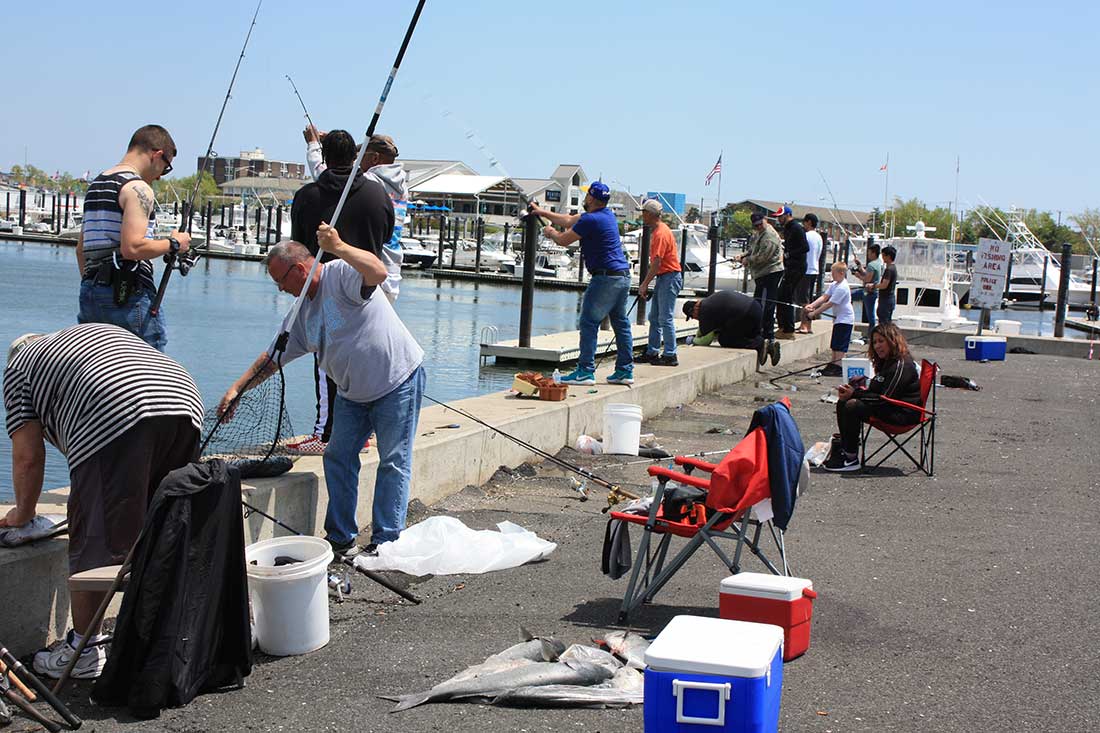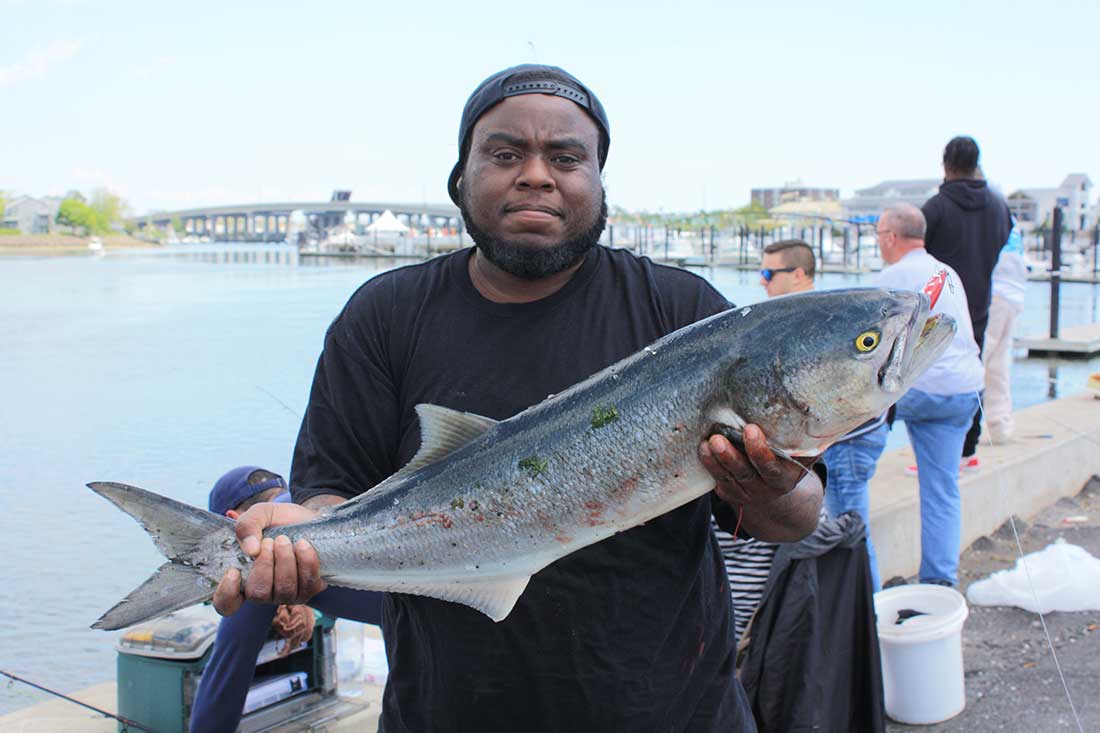
Managers pass most restrictive bluefish limits in history, while acknowledging popularity has waned as migratory patterns have changed.
New York representatives to the Mid-Atlantic Fishery Management Council (MAFMC) led the regulatory charge back in December with a motion to reduce the recreational bag limit on bluefish in 2020 to three fish for private anglers, five for those fishing on for-hire boats. The motion made by New York’s Steve Heins and seconded by New York’s Maureen Davidson at the MAFMC which manages federal waters outside of 3 miles passed by a razor thin 9-8 vote.
The Atlantic States Marine Fisheries Commission’s (ASMFC) Bluefish Board also approved the decision 7-3 by way of a motion offered by Justin Davis of Connecticut and seconded by New York’s John Maniscalco. The ASMFC’s actions are final and apply to state waters; the MAFMC decision for federal waters has been forwarded to the NOAA Fisheries Greater Atlantic Regional Fisheries Administrator for final approval, expected to come in early 2020.
While the current federal bag limit is 15 fish, the majority of coastal states from New England to Maryland currently have had a 10 fish bag limit implemented for both private anglers and party/charter boat fishermen; except in Rhode Island, New York and New Jersey where a 15 fish bag limit has been in place. In terms of size, Maryland has an 8-inch minimum, whereas New York has a 12-inch minimum on any fish kept over a 10-fish bag which is meant to minimize the amount of snapper blues retained. Suffice to say, with this new 2020 regulation for state and federal waters, private anglers who fish for snappers along the dock and/or make use of those blues as bait will be restricted to just three fish.
Overfished, No Overfishing
The 2019 bluefish stock assessment concluded that bluefish was overfished, although overfishing was not occurring in 2018. The difference between the statutory “overfished” and “overfishing” labels relates to a particular stock’s breaking point for harvest, known as its maximum sustainable yield or MSY. In fisheries management, that MSY represents the highest allowable rate for harvest before recruitment of new fish and environmental factors negatively impact a fish stock’s sustainability. Bluefish is considered “overfished” because its biomass level has been determined to be at a state where MSY is jeopardized, even though that may not be affected by actual fishing pressure nor experiencing “overfishing” (the 2018 harvest was not higher than the rate needed to produce that maximum yield). Statistically speaking, if ASMFC and MAFMC had taken no action on bluefish in December, bluefish would be considered both statutorily overfished with overfishing taking place.
The two management bodies had considered several combinations of bag and size limits, including options to set a single set of regulations for all fishing modes or different regulations for shore/private modes and the for-hire mode. Although the MAFMC’s Bluefish Monitoring Committee recommended a coastwide three-fish bag limit, public comment and feedback from members of the Bluefish Advisory Panel (AP) expressed opposition to this option, noting that it would have severe economic consequences on for-hire folks, which according to the data was responsible for just 3.6% of coastwide landings from 2016-2018.
In a joint press release issued on December 17, it was stated that AP members and the public emphasized that the proposed reductions come at a challenging time for stakeholders in the charter and party boat community considering the additional restrictions on striped bass, black sea bass, summer flounder, and scup. “After an extensive discussion and thorough consideration of public comments, the Council recommended and Commission approved a three-fish bag limit for private and shore modes and a five-fish bag limit for the for-hire mode,” the release noted, adding that no restrictions were made to minimum fish size or seasons.
According to NOAA Fisheries, the bluefish stock assessment uses landings data from the commercial and recreational fisheries, bottom trawl surveys in the fall, and numerous state surveys conducted along the East Coast. On the recreational side, actual harvest and release mortality estimates are collected through the Marine Recreational Information Program (MRIP) using random surveys to account for angler effort and landings on a year-to-year basis. Those estimates are ultimately used to track against allowable annual catch limits (ACL) while accounting for future perceived overages. The two management bodies adopted a recreational harvest limit of 9.48 million pounds for 2020 and 2021, an 18% decrease compared to 2019. However, as per estimates from the MRIP survey, the recreational sector was projected to land 13.27 million pounds – an overage of 28.56% – which resulted in the decision to cut 80% of the angler’s daily bag limit.

According to Jim Donofrio of the Recreational Fishing Alliance (RFA), it was the incorporation of these rigid and inflexible ACL requirements in the 2007 reauthorization of the Magnuson Stevens Fisheries Conservation and Management Act that has led to the continued management problems. “The environmental organizations pushed hard to have the recreational sector be under ACL’s, and I think it was purposely done because they knew that MRIP would never work and would cause us to be more precautionary, without the flexibility that we’ve all asked for.”
Thirteen years ago, the National Academy of Sciences found the telephone and access components of NOAA’s angler surveys to have “serious flaws in design or implementation,” while further citing “inadequate analysis methods” when determining angler harvest. The federal fisheries agency has since overhauled the recreational survey under orders by Congress, and now claims to utilize a “new, improved survey.” However, in a follow-up review by the National Academy of Sciences published in 2017, the nation’s leading independent research group found “challenges remain” in the MRIP survey methodology, most notably “in-season monitoring of compliance with Annual Catch Limits – have been difficult to address.”
“We still don’t have a system on the recreational side that can be used in that manner,” Donofrio said. “The only way out of this box is to have U.S. Senators and House members fully understand what we need, and what needs to be fixed, that will allow us to have continued access and continued rebuilding that can be done without having ACL’s in the recreational sector.”
Historical Snapshot
In his 1987 bestseller Blues, Pulitzer Prize winning journalist and author John Hersey writes “bluefish come and go in a way no one understands,” going on to describe how blues were plentiful off the New England coast in colonial times. “But then from about 1764 they totally disappeared and didn’t show up again until about 1810. There were tremendous catches from 1880 to about 1905, when they dropped off again for several years. There was a sharp decline again in the forties; in 1941 almost none were caught except for a few off Maryland and Virginia.”
The late John Geiser’s Guide to Saltwater Fishing also referenced the cyclical nature of bluefish going back a century. “Scientists are still at a loss for explaining the cycles of scarcity and plenty that marked the bluefish fishery from the 19th century until the 1950’s,” Geiser wrote in 2000, adding “There was a period of relative scarcity of the species in New England and Mid-Atlantic waters during World War II, but the bluefish increased in abundance from the 1950’s on, and retained its place next to the fluke and striped bass as the most popular recreational species along the coast.”
A November memo from MAFMC staffer Matthew Seeley outlined the historical importance of the recreational bluefish fishery – “For the last half of a century, bluefish have been one of the most important recreational species for not only the for-hire fleet, but recreational angling public who look forward in catching one of the most exciting inshore gamefish to which they have access to,” the memo stated, explaining how bluefish was one of the primary species which led to the aluminum party boat construction boom throughout the 1970s and 1980s and an economic drive for the bait and tackle industry in and around Long Island and metro New York. “Since that time, the popularity of bluefish has lessened due to the greater abundance and preference in fishing for striped bass, summer flounder, black sea bass and scup.”
Seeley’s memo further described changes in traditional migration patterns, which also align with documented NOAA Fisheries’ data on stock shifting due to warming waters, while directly citing New Jersey stakeholder input in an article that appeared in the Asbury Park Press in 2018. “There’s an abundance of them. They’re just 80 to 100 miles offshore where the longliners can’t keep them off the hook,” said Capt. Lenny Elich of the Miss Barnegat Light party boat of bluefish. Capt. Elich told Asbury Park Press reporter Dan Radel that bluefish were no longer on the Barnegat Ridge, precisely where many party boats used to fish for them day and night.
“It was a humongous business. We use to sail seven days a week from May to August with crowds of people,” Capt. Elich said, describing the fleet as being left “barely hanging” since bluefish stopped returning to the grounds near Barnegat Ridge sometime after Superstorm Sandy hit in October 2012. In fact, some of Elich’s Barnegat Light neighbors like the Doris Mae IV and Searcher II stopped hanging on altogether, ceasing operation in the years since.
Ray Bogan, a Point Pleasant attorney whose family has been in the party boat business at the Jersey Shore since before World War II, said the number of party boats overall has declined by 35% or more from its peak in the mid-1980s during the bluefish boom. “No new party boats, to my knowledge, have been built in the Mid-Atlantic or New England region in the last 7 years,” Bogan said, adding “that’s the first time since World War II of that trend occurring.” While those limited party boats in operation today are frequently bought and sold between neighboring states, Bogan said he knows of no new coast guard inspected for-hire vessels being built.
“These vessels that were the only means by which people of lower socioeconomic status could get out on the water are being eliminated,” Bogan explained. “We’ve seen a relatively tiny surge in guide fishing, where folks of some wealth or means are able to go out and specialize in adaptive fisheries, but when you have a larger vessel that is attracting people with limited means, and they have to plan their trips, and any expenditure of money for them is significant and has to be accompanied by the possibility of a reward of a big day, when that it is eliminated then we lose that whole group of people. We’ve shut them out from this fishery.” Bogan said such actions by both MAFMC and ASMFC on numerous fisheries over the past 15 years have disproportionally impacted minorities and anglers of lower socioeconomic status.
Seeley’s memo recognizes that “noticeable socio-demographic change in the population of fishermen who target saltwater fish in the downstate region of New York over the last two decades.”
“Among the failures of fishery managers, one that has been particularly disturbing is the failure of some of them to research and learn the history of the fisheries they are managing,” Bogan added, citing the cyclical nature of bluefish as a primary example. “Many of us remember, well, the periods in the 1960s, for example, when blues disappeared for stretches, or the bad days of black sea bass in the 1960s.”
“Instead, history to them is what they decide it is,” Bogan concluded.




